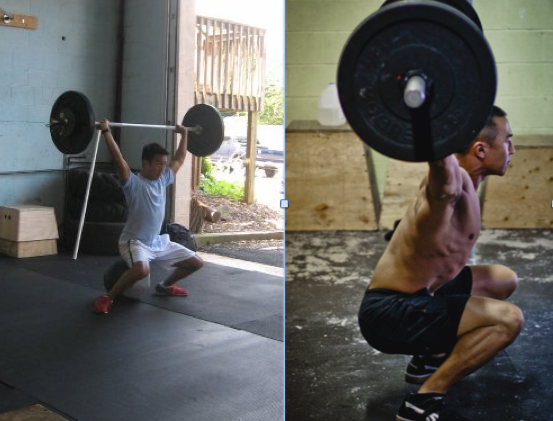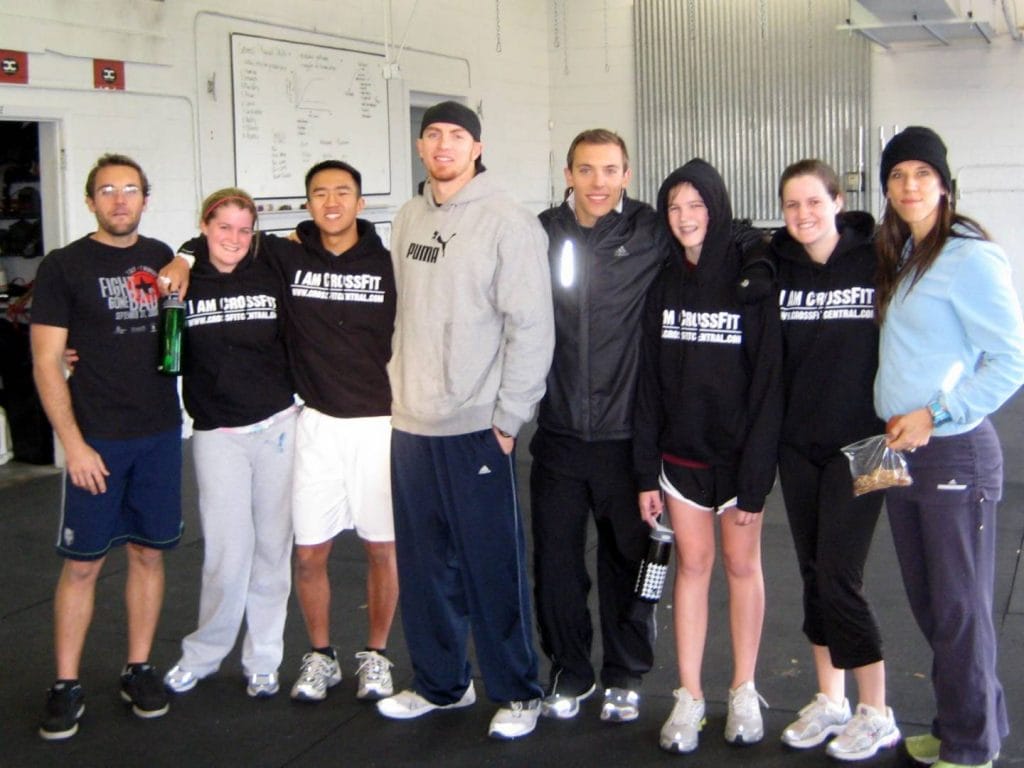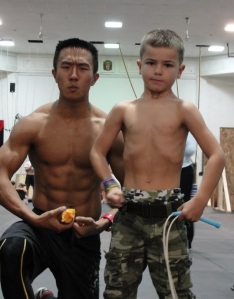Coach Chris here. Today marks 10 years since I did my first CrossFit workout. I was in grad school and had heard about CrossFit from my now father-in-law. Coincidentally I also had watched the movie “300” and a documentary on how they got fit. After making the connection, I stalked CrossFit.com watching their videos and looking up movements for well over a month before actually trying it myself. This was the workout posted on main site for January 31, 2008. [Mainsite posts the WOD the day before and I must have done it that afternoon or night of the 30th] :
Since I was working out alone, I had to scale for myself, but I had no idea how to do it. Luckily, there was a forum called Brand X which offered several ways to scale. Also lucky for me was not realizing they snuck “Fran” and “Diane” in there by changing the format. Not that I knew what those names meant anyway. Here is my first post after completing the workout:
If you can’t read that, here it is:
“1st timer
First time ever doing crossfit, trying to get in a good workout routine. Never liked doing big lifting but after feeling my lower back during dead lifts, can see the value in them.
Modified:
95# dead 10 reps
feet on 3’ box HSPU 10 reps
strict pullups 5 reps x 2 sets
65# thrusters 10 reps (1st set, then dropped to 45# for last 2 sets)
12:42
Does anyone work running into the WOD?”
You see, since running was “the thing” to do after college, that’s primarily what I did. So it took a long time for me to get the idea that doing this shorter, intense workouts was all I needed. Being on the smaller side, I was able to lift my bodyweight for pull-ups, but that was about it. Anything with a barbell was like speaking a foreign language. In my first weeks, I remember:
- 95# deadlifts feeling really awkward. I didn’t go much higher than that.
- I also wrote “new to back squats: 95/135/155/185 need to work on form” (was definitely not at or below parallel)
- My push jerk? 105# and that was probably with very poor form
- Filthy Fifty I scaled to 35’s and scaled a lot of the movements
It only took 2 short years to turn those awkward 95# deadlifts into a 415# deadlift which I thought would be my lifetime max. But then 5 shorter years later it was a 500+ lb. deadlift. Other lifetime PRs are 400 lb. back squat, 2:33 “Fran” and 52 unbroken pull-ups (just a month ago). This is all to say that although I didn’t grow up as a gym rat, the improvements came over time and are still coming.
Nowadays, having a kid, opening a box last year, and just generally getting older means I’m probably not in the best shape of my life right now since personal fitness is not my priority, but I do have the experience of the past 10 years where I have learned a few lessons. Here are ten of them.
#1: Mechanics. Consistency. Intensity. And then back to Mechanics.
In CrossFit, being fast is better. You can’t jump on a 50″ box slowly. You can’t clean 225# slowly. The faster you are, the better. The caveat, of course, is that you need to have the form down first, then you can go fast. It’s not worth going fast if it’s going to be slop. Learn the mechanics of the movement first, then be consistent with it, then you can layer on intensity in the form of bigger weights or faster movement. But then at some point, you’ll probably have to back down to mechanics when bigger weights mean sloppier form. It’s this dialing back and forth between mechanics and intensity that is the trick to progress.
#2. If you want to be good at something, you need to do it.
I was once intimidated by the 70 lb. kettlebell. The idea of swinging a piece of metal that was half my bodyweight over my head was not all that appealing. But there came a point where 70 lb. kb swings were showing up in WODs more frequently. I knew I needed to swing it, so I just DID. At first, I only did Russian swings (to eye level) and once I got comfortable, I went a little overhead, and a little more. Eventually I could do a few reps and then have to set it down. While I don’t suggest just picking up a 70 pounder if you’ve been using a 26, don’t be intimidated to do something heavier or more difficult than what you currently do. If you want to be better at double unders, practice them. If you want to be better at cleans and snatches, you need to do cleans and snatches. You get the idea.
#3: Consistency is key.
Whether it’s nutrition, strength, endurance, or skill, consistency is key. I can be on-point with my nutrition for 3 months, but one bad week can set me back that entire time. Same thing when it comes to working out. Recovery days are absolutely vital, but taking an extended period of time off will set you back months or even years. After my shoulder surgery in 2012, I went on a pity party for myself and barely worked out for 2 months. When I finally did a mini-metcon that lasted about 4 minutes, I almost puked. Consistency is key, so do whatever you can to avoid playing catch up.

#4: Mobility matters – a lot more than you want it to.
Weightlifting is a big part of CrossFit. Doing the cleans, jerks, and snatches play an integral role in being athletic, strong, and they are great markers for transferability (how well that athlete can do other things.) After coaching hundreds of athletes, the ones who have better mobility tend to succeed more at these movements. Being mobile doesn’t mean being the MOST flexible person, but good mobility establishes a foundation for being in good athletic positions. I can take a super strong dude who benches 315 for reps, but if he doesn’t have the mobility to squat below parallel, these movements are going to be really tough for him. Conversely, I’ve seen a plethora of supple athletes who had no idea what a clean was, but because they could sit ass to grass with a PVC pipe overhead, they were able to start with light weight and work themselves up to bodyweight+ snatches and 1.5x+ bodyweight clean and jerks in short time. Mobility is the one thing we all know deep down matters, but hate working on if we don’t have it.
#5: Nutrition is simpler than you think
Ten years ago, I started changing my nutrition by following the Zone Diet. Then it was Paleo. Then Zaleo. And then an avalanche of Whole30, IIFYM, keto, Intermittent Fasting, carb backloading, DASH, raw, gluten-free, and many other diets followed and will continue to spread through the CrossFit community. But at the end of the day, Greg Glassman had it stated the most elegantly:
Eat meat and vegetables, nuts and seeds, some fruit, little starch, and no sugar. Keep intake to levels that will support exercise but not body fat.
Eat real food. Not too much. That’s pretty much it. If you exercise more, then eat more. Lately, I’ve been having a lot of conversations with our athletes about NEEDING to eat more because they don’t realize how potent these workouts are.Macros or Zone are fine to get people started with something, but at the end of the day food quality trumps food quantity for health and wellness.
#6. Women benefit more from lifting weights than guys do.
After training hundreds of women, I’ve noticed women get more out of the barbell than most guys. Teens, twenty-year-olds, sixty-year-olds and up; not only is there a benefit for health and longevity, but they also get stronger mentally and emotionally. Most women do not train with real weights before CrossFit. But now it’s normal and expected that they deadlift 200+ pounds, bench press 100+ pounds, and do unassisted pull ups. This is cool! Unsurprisingly, they even lean out, don’t get bulky like they think, and suddenly stresses at work or home are easier to deal with because they think of that crazy-ass metcon they did yesterday. Teenage girls suddenly have a new definition of “beauty” and eat for performance instead of starving themselves. I’m not saying that guys don’t get the same benefits, but on average, I’ve seen the impact of weight training affect women way more than guys.
#7: Squat heavy and often. And sprint.
If you only have time for one thing, squat. As in squat with a heavy barbell on your back. I’ve found that heavy squats transfer a great deal to other things: running faster, jumping higher, and even losing fat. If you don’t have a barbell and weights, then sprint. It will have a similar effect.
#8: Injuries are no fun. But you’ll be ok.
I needed shoulder surgery after getting injured in a competition and that took me out for the better part of a year from doing most movements in CrossFit. I’ve had several other little things and I’ve worked with dozens of people with temporary and/or permanent disabilities. The best thing about CrossFit is its adaptability to people’s needs. If you get hurt, yes it’s a bummer, but that doesn’t mean you have to stop moving. A good coach will be able to adapt any movement or progression to your needs. There are CrossFitters who are quadriplegics, blind, deaf, and everything in between. If they can do it, so you can you. And look on the bright side – not being able to do some movements means you can get REALLY good at other movements. Brent Fikowski was able to podium at the CrossFit Games after a hip injury that made him work on his weakness: upper body strength.

#9: CrossFit is secretly for everyday people, not just competitors.
The CrossFit Games is a showcase of the world’s fittest men and women putting themselves through ridiculous feats of athleticism, but the soul of CrossFit is for the everyday people. Having been to Regionals on a team, I can tell you it’s really fun to compete, but that’s not why CrossFit is valuable. The human population is on a decline when it comes to health. There are an exponential amount of deaths related to chronic disease like diabetes, cardiovascular disease, etc. compared to just 100 years ago. CrossFit offers an elegant solution to a chronic problem. Exercise using functional fitness at a high intensity 3-5x/week; eat real, nutritious food; get a good amount of sleep; have a strong community. These are the secrets to health and wellness and CrossFit offers all of these things under one roof. How do we know? Because when people do these things, we see them get off medicines they’ve been taking for years. We see them lean out and feel 10 years younger. We see them change their lives for the better in more ways than just fitness. We don’t need studies to tell us this because we see it in person day to day at the box.
#10: CrossFit will be around forever in some shape or form
Trends come and go. Shiny new objects and fitness routines and diets will be hot for a few years and then fade off because while they are fun at the time, they’re usually one-dimensional and can’t stand the test of time. The principles of CrossFit that I talked about in the points above are ever-lasting and they help people get healthy in ways most or all other fitness routines don’t. We get people coming in our door who say they’re bored with _________ routine, but rarely do people leave CrossFit for something “better.” (If they do leave, it’s usually for weightlifting as a sport, but not for general physical preparedness.) CrossFit itself has evolved – back when I started, 155 lb. clean and jerks were considered heavy and getting a muscle-up was a huge achievement. While those are still true for many people, the upper boundaries on human performance continue to be pushed higher and higher. But the essence of constantly varied movement done at high intensity will last forever simply because it works. Could there be a better methodology in the future? Possibly. But until then, those looking to be fit for the real world and for their loved ones should stick with CrossFit.







Pingback: Lurkers - CrossFit Kanna